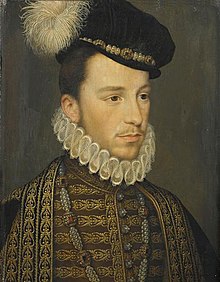Henri de Silly
In early 1585, he allied himself with the rebellious Catholic Ligue (League) and fought against the crown under the command of the duc d'Elbeuf in Normandie.
[8] They had the following issue:[1] In 1573, La Roche-Guyon travelled with the duc d'Anjou as part of his household as he left France to establish himself in his new kingdom of the Polish-Lithuanian Commonwealth.
[11] Unlike many of Anjou's companions during his brief reign in the Commonwealth, La Roche-Guyon stayed with him until his flight from the kingdom to assume the throne of France.
[12] Upon Anjou's return to France as Henri III, the duc de Nevers who had been a long time companion of the prince felt as if he had been cut out of access to royal patronage in favour of new men.
[15] La Roche-Guyon was indignant that she had been given to a man of lower social status with the attention of aggrandising the standing of a royal favourite.
[16] In March 1579 Henri made concessions to the Norman Estates, offering a small reduction in the taille and a confirmation of their charter, however this failed to sooth things.
In lower Normandie the peasantry had entered rebellion, Rouen had rioted and several lords (La Roche-Guyon, Chantelou and Pont-Bellenger) were rumoured to be planning to kidnap the king while he was staying at Saint-Germain.
[18] It was alleged that all these disorders were the work of the agents of the duc d'Alençon who wished to distract Spanish attention from his plans to restart campaigning into Nederland.
[19] Henri issued an arrest warrant for La Roche-Guyon, Chantelou and Pont-Bellenger on the grounds of how they had acted during the provincial Estates, and raising of soldiers.
At this time the prince de Condé had also seized La Fère and Catherine departed to Picardie to try to talk him down from provoking a new Catholic backlash by his provocative acts.
[18] Also present in Nancy was the Protestant mercenary leader Pfalz-Simmern who was owed significant sums of money by France for his involvement in the Fifth French War of Religion in 1575, which the crown struggled to pay, and therefore he continually menaced the kingdom with invasion.
[22] It was agreed eventually that in return for receipt of several cities, Pfalz-Simmern would invade France with 5000 reiters, while La Roche-Guyon would raise gentleman in Normandie in support of the project.
[23] With the Catholic ligue (League) entering a state of war with the crown in 1585, La Roche-Guyon and the seigneur de Chantelou rallied to the cause, lacking an alternative royal patron.
Despite this, Henri capitulated to the ligue on 7 July, agreeing to outlaw Protestantism and granted the members of the Lorraine family who led the organisation various surety towns.


